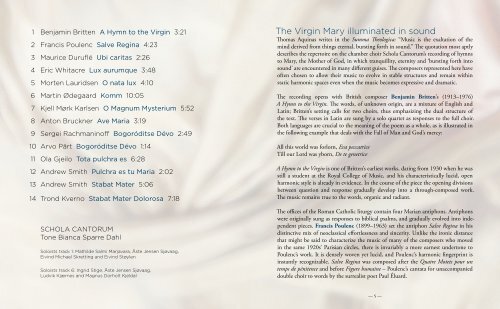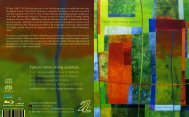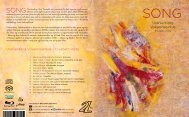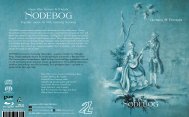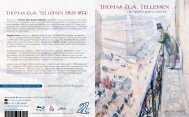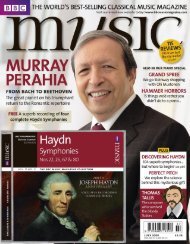Create successful ePaper yourself
Turn your PDF publications into a flip-book with our unique Google optimized e-Paper software.
1 Benjamin Britten A <strong>Hymn</strong> <strong>to</strong> <strong>the</strong> <strong>Virgin</strong> 3:21<br />
2 Francis Poulenc Salve Regina 4:23<br />
3 Maurice Duruflé Ubi caritas 2:26<br />
4 Eric Whitacre Lux aurumque 3:48<br />
5 Morten Lauridsen O nata lux 4:10<br />
6 Martin Ødegaard Komm 10:05<br />
7 Kjell Mørk Karlsen O Magnum Mysterium 5:52<br />
8 An<strong>to</strong>n Bruckner Ave Maria 3:19<br />
9 Sergei Rachmaninoff Bogoróditse Dévo 2:49<br />
10 Arvo Pärt Bogoróditse Dévo 1:14<br />
11 Ola Gjeilo Tota pulchra es 6:28<br />
12 Andrew Smith Pulchra es tu Maria 2:02<br />
13 Andrew Smith Stabat Mater 5:06<br />
14 Trond Kverno Stabat Mater Dolorosa 7:18<br />
SCHOLA CANTORUM<br />
Tone Bianca Sparre Dahl<br />
Soloists track 1: Mathilde Salmi Marjavara, Åste Jensen Sjøvaag,<br />
Eivind Michael Skretting and Eivind Støylen<br />
Soloists track 6: Ingrid Stige, Åste Jensen Sjøvaag,<br />
Ludvik Kjærnes and Magnus Dorholt Kjeldal<br />
The <strong>Virgin</strong> Mary illuminated in sound<br />
Thomas Aquinas writes in <strong>the</strong> Summa Theologica: “Music is <strong>the</strong> exaltation of <strong>the</strong><br />
mind derived from things eternal, bursting forth in sound.” The quotation most aptly<br />
describes <strong>the</strong> reper<strong>to</strong>ire on <strong>the</strong> chamber choir Schola Can<strong>to</strong>rum’s recording of hymns<br />
<strong>to</strong> Mary, <strong>the</strong> Mo<strong>the</strong>r of God, in which tranquillity, eternity and ‘bursting forth in<strong>to</strong><br />
sound’ are encountered in many different guises. The composers represented here have<br />
often chosen <strong>to</strong> allow <strong>the</strong>ir music <strong>to</strong> evolve in stable structures and remain within<br />
static harmonic spaces even when <strong>the</strong> music becomes expressive and dramatic.<br />
The recording opens with British composer Benjamin Britten’s (1913–1976)<br />
A <strong>Hymn</strong> <strong>to</strong> <strong>the</strong> <strong>Virgin</strong>. The words, of unknown origin, are a mixture of English and<br />
Latin; Britten’s setting calls for two choirs, thus emphasizing <strong>the</strong> dual structure of<br />
<strong>the</strong> text. The verses in Latin are sung by a solo quartet as responses <strong>to</strong> <strong>the</strong> full choir.<br />
Both languages are crucial <strong>to</strong> <strong>the</strong> meaning of <strong>the</strong> poem as a whole, as is illustrated in<br />
<strong>the</strong> following example that deals with <strong>the</strong> Fall of Man and God’s mercy:<br />
All this world was forlorn, Eva peccatrice<br />
Till our Lord was yborn, De te genetrice<br />
A <strong>Hymn</strong> <strong>to</strong> <strong>the</strong> <strong>Virgin</strong> is one of Britten’s earliest works, dating from 1930 when he was<br />
still a student at <strong>the</strong> Royal College of Music, and his characteristically lucid, open<br />
harmonic style is already in evidence. In <strong>the</strong> course of <strong>the</strong> piece <strong>the</strong> opening divisions<br />
between question and response gradually develop in<strong>to</strong> a through-composed work.<br />
The music remains true <strong>to</strong> <strong>the</strong> words, organic and radiant.<br />
The offices of <strong>the</strong> Roman Catholic liturgy contain four Marian antiphons. Antiphons<br />
were originally sung as responses <strong>to</strong> biblical psalms, and gradually evolved in<strong>to</strong> independent<br />
pieces. Francis Poulenc (1899–1963) set <strong>the</strong> antiphon Salve Regina in his<br />
distinctive mix of neoclassical effortlessness and sincerity. Unlike <strong>the</strong> ironic distance<br />
that might be said <strong>to</strong> characterize <strong>the</strong> music of many of <strong>the</strong> composers who moved<br />
in <strong>the</strong> same 1920s’ Parisian circles, <strong>the</strong>re is invariably a more earnest under<strong>to</strong>ne <strong>to</strong><br />
Poulenc’s work. It is densely woven yet lucid, and Poulenc’s harmonic fingerprint is<br />
instantly recognizable. Salve Regina was composed after <strong>the</strong> Quatre Motets pour un<br />
temps de pénitence and before Figure humaine – Poulenc’s cantata for unaccompanied<br />
double choir <strong>to</strong> words by <strong>the</strong> surrealist poet Paul Éluard.<br />
— 5 —


